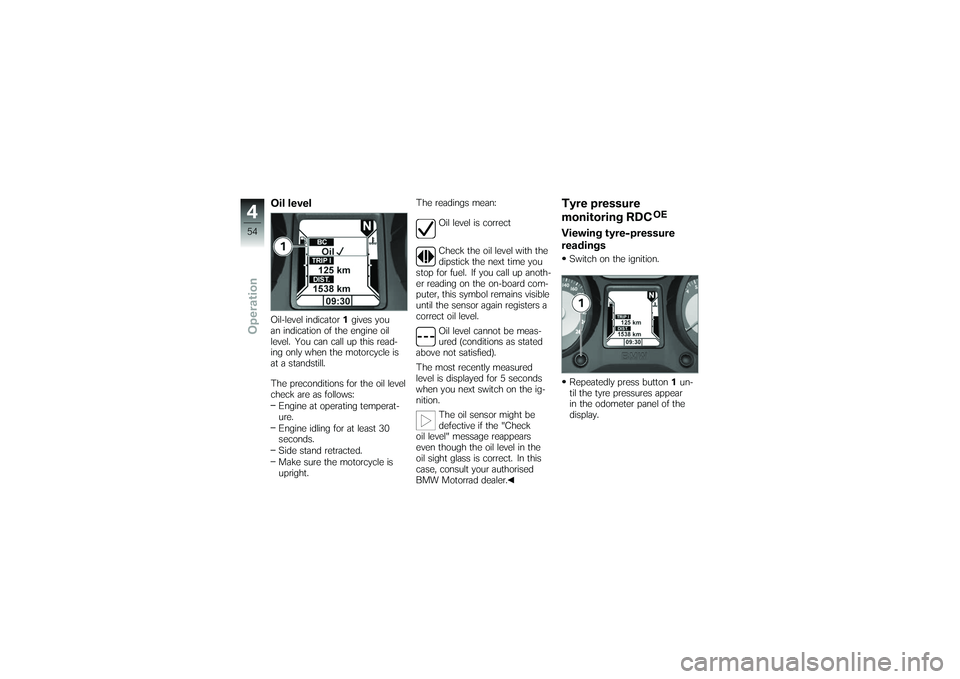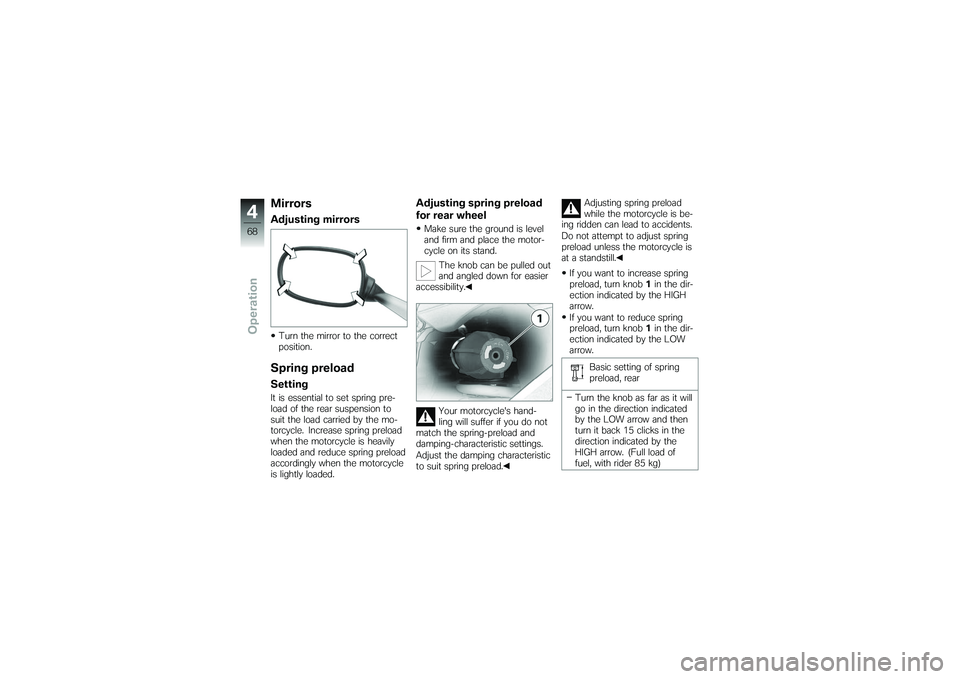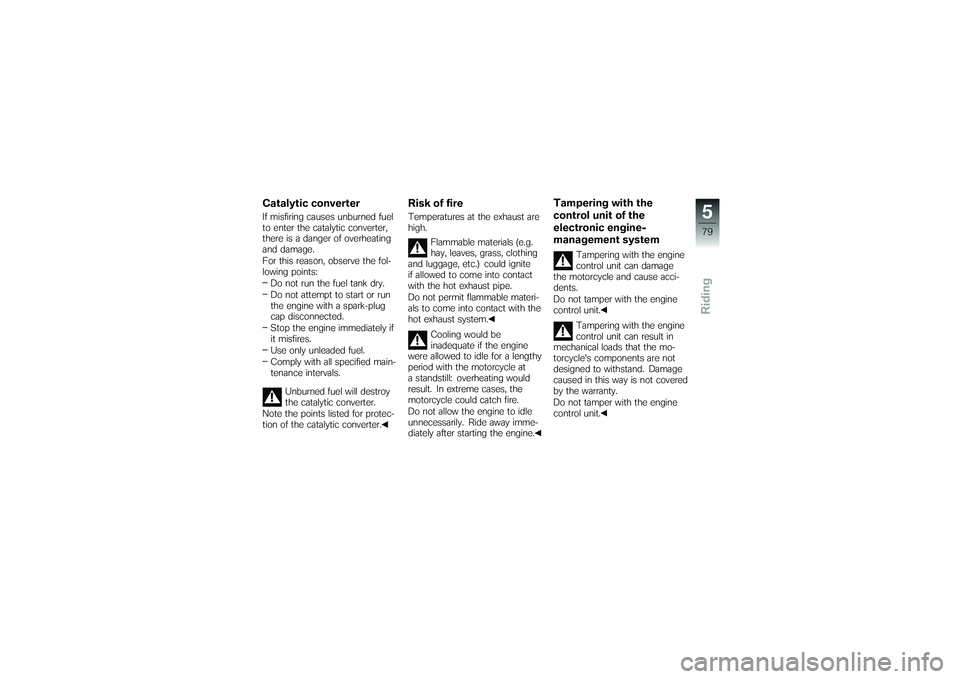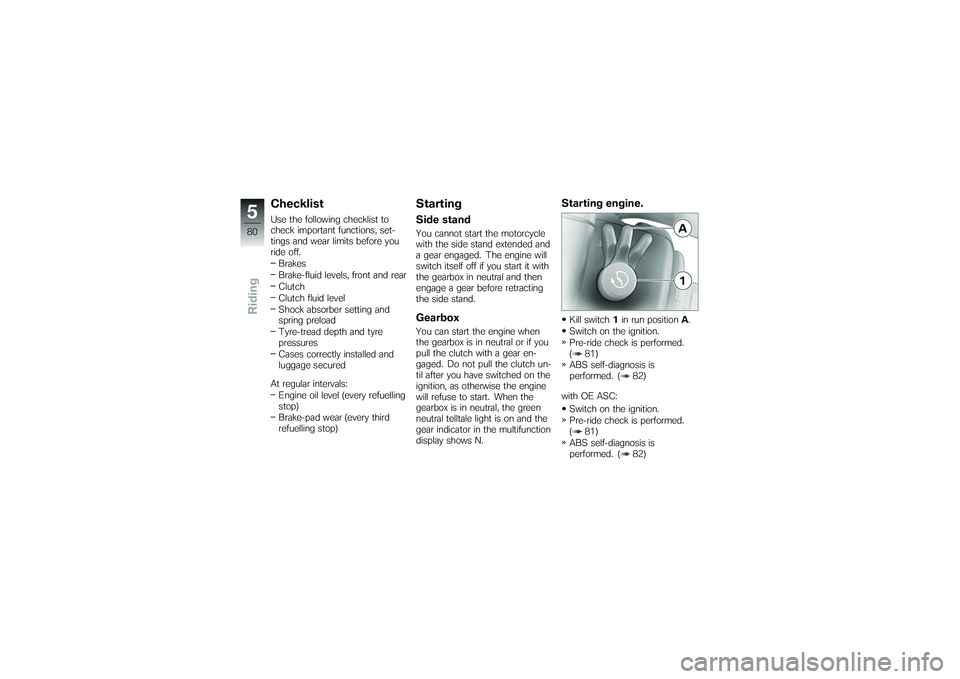Page 55 of 173
Average speedAverage speed1is calculated
on the basis of the time elapsed
since the last reset. Times
during which the engine was
stopped are excluded from the
calculation.Resetting average speedSwitch on the ignition.
Select average speed. Press and hold down button
1.
Average speed is reset to zero.
Average consumptionAverage consumption 1is cal-
culated by dividing the distance
covered since the last reset by the corresponding amount of fuel
used.
Resetting average
consumptionSwitch on the ignition.
Select average consumption.
Press and hold down button
1.
Average consumption is reset
to zero.
453zOperation
Page 56 of 173

Oil levelOil-level indicator1gives you
an indication of the engine oil
level. You can call up this read-
ing only when the motorcycle is
at a standstill.
The preconditions for the oil level
check are as follows:
Engine at operating temperat-
ure.
Engine idling for at least 30
seconds.
Side stand retracted.
Make sure the motorcycle is
upright. The readings mean:
Oil level is correct
Check the oil level with the
dipstick the next time you
stop for fuel. If you call up anoth-
er reading on the on-board com-
puter, this symbol remains visible
until the sensor again registers a
correct oil level.
Oil level cannot be meas-
ured (conditions as stated
above not satisfied).
The most recently measured
level is displayed for 5 seconds
when you next switch on the ig-
nition.
The oil sensor might be
defective if the "Check
oil level" message reappears
even though the oil level in the
oil sight glass is correct. In this
case, consult your authorised
BMW Motorrad dealer.
Tyre pressure
monitoring RDC
OE
Viewing tyre-pressure
readingsSwitch on the ignition.
Repeatedly press button 1un-
til the tyre pressures appear
in the odometer panel of the
display.
454zOperation
Page 70 of 173

MirrorsAdjusting mirrorsTurn the mirror to the correct
position.Spring preloadSettingIt is essential to set spring pre-
load of the rear suspension to
suit the load carried by the mo-
torcycle. Increase spring preload
when the motorcycle is heavily
loaded and reduce spring preload
accordingly when the motorcycle
is lightly loaded.
Adjusting spring preload
for rear wheelMake sure the ground is level
and firm and place the motor-
cycle on its stand.The knob can be pulled out
and angled down for easier
accessibility.
Your motorcycle's hand-
ling will suffer if you do not
match the spring-preload and
damping-characteristic settings.
Adjust the damping characteristic
to suit spring preload. Adjusting spring preload
while the motorcycle is be-
ing ridden can lead to accidents.
Do not attempt to adjust spring
preload unless the motorcycle is
at a standstill.
If you want to increase spring
preload, turn knob 1in the dir-
ection indicated by the HIGH
arrow.
If you want to reduce spring
preload, turn knob 1in the dir-
ection indicated by the LOW
arrow.
Basic setting of spring
preload, rear
Turn the knob as far as it will
go in the direction indicated
by the LOW arrow and then
turn it back 15 clicks in the
direction indicated by the
HIGH arrow. (Full load of
fuel, with rider 85 kg)
468zOperation
Page 79 of 173
Riding
Riding
Safety instructions . .................. 78
Checklist . ............................ 80
Starting . . ............................ 80
Running in ........................... 83
Brakes . . . ............................ 84
Parking your motorcycle . ............ 85
Refuelling ............................ 87
577zRiding
Page 81 of 173

Catalytic converterIf misfiring causes unburned fuel
to enter the catalytic converter,
there is a danger of overheating
and damage.
For this reason, observe the fol-
lowing points:Do not run the fuel tank dry.
Do not attempt to start or run
the engine with a spark-plug
cap disconnected.
Stop the engine immediately if
it misfires.
Use only unleaded fuel.
Comply with all specified main-
tenance intervals.
Unburned fuel will destroy
the catalytic converter.
Note the points listed for protec-
tion of the catalytic converter.
Risk of fireTemperatures at the exhaust are
high.
Flammable materials (e.g.
hay, leaves, grass, clothing
and luggage, etc.) could ignite
if allowed to come into contact
with the hot exhaust pipe.
Do not permit flammable materi-
als to come into contact with the
hot exhaust system.
Cooling would be
inadequate if the engine
were allowed to idle for a lengthy
period with the motorcycle at
a standstill: overheating would
result. In extreme cases, the
motorcycle could catch fire.
Do not allow the engine to idle
unnecessarily. Ride away imme-
diately after starting the engine.
Tampering with the
control unit of the
electronic engine-
management system
Tampering with the engine
control unit can damage
the motorcycle and cause acci-
dents.
Do not tamper with the engine
control unit.
Tampering with the engine
control unit can result in
mechanical loads that the mo-
torcycle's components are not
designed to withstand. Damage
caused in this way is not covered
by the warranty.
Do not tamper with the engine
control unit.
579zRiding
Page 82 of 173

ChecklistUse the following checklist to
check important functions, set-
tings and wear limits before you
ride off.Brakes
Brake-fluid levels, front and rear
Clutch
Clutch fluid level
Shock absorber setting and
spring preload
Tyre-tread depth and tyre
pressures
Cases correctly installed and
luggage secured
At regular intervals: Engine oil level (every refuelling
stop)
Brake-pad wear (every third
refuelling stop)
StartingSide standYou cannot start the motorcycle
with the side stand extended and
a gear engaged. The engine will
switch itself off if you start it with
the gearbox in neutral and then
engage a gear before retracting
the side stand.GearboxYou can start the engine when
the gearbox is in neutral or if you
pull the clutch with a gear en-
gaged. Do not pull the clutch un-
til after you have switched on the
ignition, as otherwise the engine
will refuse to start. When the
gearbox is in neutral, the green
neutral telltale light is on and the
gear indicator in the multifunction
display shows N.
Starting engine.Kill switch 1in run position A.
Switch on the ignition.
Pre-ride check is performed.
( 81)
ABS self-diagnosis is
performed. ( 82)
with OE ASC: Switch on the ignition.
Pre-ride check is performed.
( 81)
ABS self-diagnosis is
performed. ( 82)
580zRiding
Page 89 of 173

Refuelling
Fuel is highly flammable. A
naked flame close to the
fuel tank can cause a fire or ex-
plosion.
Do not smoke. Never bring a
naked flame near the fuel tank.
Fuel expands when hot.
Fuel escaping from an
overfilled tank could make its way
onto the rear tyre. This could
cause a fall.
Do not fill the tank past the bot-
tom edge of the filler neck.
Fuel attacks plastics, which
become dull or unsightly.
Wipe off plastic parts immediately
if they come into contact with
fuel.
Fuel can attack the material
of the windscreen and the
side slipstream deflectors, which
become dull or unsightly.
Wipe off the windscreen and slip- stream deflectors immediately
if they come into contact with
fuel.
Leaded fuel will destroy the
catalytic converter.
Use only unleaded fuel.
Make sure the ground is level
and firm and place the motor-
cycle on its stand.
Open the protective cap.
Open the fuel tank cap with
the ignition key by turning it
counter-clockwise.
Refuel with fuel of the grade
stated below; do not fill the tank past the bottom edge of
the filler neck.
Recommended fuel
grade
98 ROZ/RON (Premium plus
unleaded)
95 ROZ/RON (Premium
unleaded (fuel grade,
usable with power- and
consumption-related
restrictions)) Usable fuel capacity
24 l Reserve fuel
4l
Press the filler cap down firmly
to close.
Remove the key and close the
protective cap.
587zRiding
Page 140 of 173

Care productsBMW Motorrad recommends
that you use the cleaning and
care products you can obtain
from your authorised BMW Mo-
torrad dealer. The substances in
BMW Care Products have been
tested in laboratories and in prac-
tice; they provide optimised care
and protection for the materials
used in your vehicle.The use of unsuitable
cleaning and care products
can damage vehicle components.
Do not use solvents such as cel-
lulose thinners, cold cleaners,
fuel or the like, and do not use
cleaning products that contain
alcohol.Washing motorcycleBMW Motorrad recommends
that you use BMW insect re-
mover to soften and wash off
insects and stubborn dirt on painted parts prior to washing
the motorcycle.
To prevent stains, do not wash
the motorcycle immediately after
it has been exposed to strong
sunlight and do not wash it in the
sun.
Make sure that the motorcycle
is washed frequently, especially
during the winter months.
To remove road salt, clean the
motorcycle with cold water im-
mediately after every trip.
After the motorcycle has
been washed, ridden
through water or ridden in
the rain, the brake discs and
pads might be wet and the
brakes might not take effect
immediately.
Apply the brakes in good time
until the brakes have dried out.
Warm water intensifies the
effect of salt. Use only cold water to wash off
road salt.
The high pressure of steam
cleaners can damage seals,
the hydraulic brake system, the
electrical system, and the seat.
Do not use a steam jet or high-
pressure cleaning equipment.
Cleaning easily
damaged componentsPlasticsClean plastic parts with water
and BMW plastic care emulsion.
This includes in particular:
Windscreen and slipstream de-
flectors
Headlight lens made of plastic
Glass cover of the instrument
cluster
Black, unpainted parts
If plastic parts are cleaned
using unsuitable cleaning
9138zCare